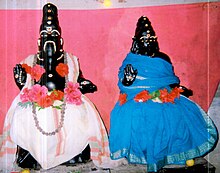Lopamudra
| Lopamudra | |
|---|---|

Agastya and Lopāmudrā
|
|
| Information | |
| Spouse(s) | Agastya |
Lopamudra (Sanskrit: लोपामुद्रा) also known as Kaushitaki and Varaprada was a female philosopher according to ancient Vedic Indian literature. She was the wife of the sage Agastya who is believed to have lived in the Rigveda period (2600–1950 BC) as many hymns have been attributed as her contribution to this Veda. She was not only the consort of Agastya but a Rishiki in her own right, as she was the well known rishiki who wrote the "Panchadasi" (Vedanta) mantra of the Sakta tradition of Hinduism.
There are three versions of Lopamudra' legend; one is in the Rigveda Hymns; the second is in the epic Mahabharata (Vanaparva: Tirtha-yatra Parva), where there is an elaborate version with a mention that Agastya Rishi did penance at Gangadwara (Haridwar), with the help of his wife, Lopamudra (the princess of Vidarbha). According to legend, Lopamudra was created by sage Agastya with the most graceful parts of animals such as eyes of the deer etc.; and the third version is Giridhara Ramayana.
The name Lopamudra signifies the loss (lopa) that the animals and plants suffered by giving their distinctive beauties (mudra's) when Agastya created her. After creating her, Agastya gave Lopamudra to the King of Vidarbha who was doing penance seeking for a progeny. Agastya had created Lopamudra with the intention of marrying her. The king brought up Lopamudra as his daughter. When she grew up, Agastya demanded her hand in marriage. Lopamudra agreed to marry him and left the King's palace for his hermitage. However, after some time, she grew tired of Agastya's austerity. She wrote hymn in the Rigveda, asking for his attention and love. The hymn made Agastya realize his duties towards his wife. The couple had a son named Dridhasyu, who became a poet.
Together with her husband she is also credited with spreading the fame of the Lalita sahasranama (the thousand names of the Divine Mother). It is also believed that Agastya learnt the hymns of Lalitha Sahasranama from Hayagriva who is an avatar of Lord Vishnu.
In Rigveda, hymns authored by 27 female rishis or rishikas reflect their success and progress as women intellectuals. These hymns are presented under three headings. The first group has hymns contributed by female rishis only such as by Vishwavara and Apale; Vishwavara's hymn is dedicated to Agni while Apale's hymn is about Indra. In the second group some are attributed to female rishis, particularly Lopamudra and Shashiyasi, wife of Taranta. Lopamudra's hymn has six verses in particular which have her name tag and are dedicated to Goddess Rati. Her hymns elaborate on the relationship between husband and wife in order to follow celibacy. Lopamudra is credited to have composed hymn number 179 in the Rigveda. The third group of hymns, though attributed to female rishis are not identified by any author and deal mostly with mythological characters and representation of theoretical qualities. In Rigveda Agastya and Lopamudra are considered as "mantra drashta" (seers who are discoverer of mantras). She is also mentioned in Yajurveda (17:11:36:20) Brihaddevtakara (4:57–59) and in Agama granthas, and hailed as "Mantradrika" (well versed in mantras) in Rigveda.
...
Wikipedia
